The copper plating quality of printed circuit board is closely related to the application reliability of printed circuit board. With the development of printed boards to high density and high precision, the requirements for copper plating are also higher and higher. It is not only required that the coating is uniform and fine, but also that it is free of defects such as pits, pinholes, pits, incomplete copper coating, etc. The pitting defect of copper plating was the main problem affecting the surface quality of copper plating in our institute. Starting from the two production processes of graphic transfer and graphic electroplating, this paper expounds how to optimize the process parameters and carry out strict production control to reduce the probability of copper plating pits printed circuit board and ensure the quality of copper coating.
1. Shape of pit defect
The copper plating pit refers to the dotted pit on the large copper surface, line and pad after the graphic copper plating. Generally, it mainly exists on the line or pad edge (as shown in Figure 1).
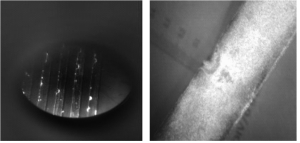
Figure 1 Copper plating pit
The metallographic section of the pit is as shown in Figure 2. It can be seen that the copper plating at the pit is incomplete, and some of them are not even plated with copper.

Figure 2 Copper plating pit
2. Cause analysis and control measures
Fault tree of copper plating pit (Fig. 3)
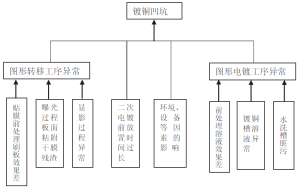
Figure 3 Copper plating pit fault tree
2.1 Graphic transfer process
Pattern transfer refers to the transfer of the circuit image on the photographic plate to the copper-clad laminate to form an etching or electroplating resistant mask image. The operation process is as follows: plate brushing → film pasting → exposure → development.
2.1.1 Influence of brush plate effect on copper plating pits
The purpose of graphic transfer brush board is to remove oxidation and dirt on the printed board surface. If the brushing machine does not clean the board surface, the excess on the board surface will inhibit the copper plating and form copper plating pits. For a period of time, copper plating pit defects occurred frequently in our research institute. After metallographic sectioning of the pit, it can be seen that there are obvious foreign matters on the second copper that hinder its continued electroplating (see Figure 4). The reason is that the mesh number of abrasive brush roller type brush used is not appropriate, the effect of brush plate is poor, and the application of brush roller is aging (the mesh number of brush roller in the first section is 320, and the mesh number of brush roller in the second section is 500). After replacing the first section of the brush machine with 500 mesh and the second section with 800 mesh, the copper plating pit defect disappeared.

Figure 4 Copper plating pit
2.1.2 Dry film residue adhered to the plate surface during graphic transfer exposure
In the process of image transfer alignment and exposure, there is dry film residue in the alignment table and exposure machine. If it is not cleaned in time, it will cause copper plating pits after adhering to the plate surface, which may cause serious wire breakage (see Figure 5). To solve this problem, it is necessary to regularly clean the exposure machine. Before work, it is necessary to use the electrostatic precipitator roll to adhere the excess sundries on the alignment table, exposure machine and exposure clamp, and use wiping paper dipped in anhydrous alcohol to clean the alignment table and exposure clamp. According to the actual situation, it is required to regularly clean the exposed glass, the upper and lower parts of the Mylar film, the countertop and the use of the negative film. Generally, it is recommended to clean at least once every five exposures.
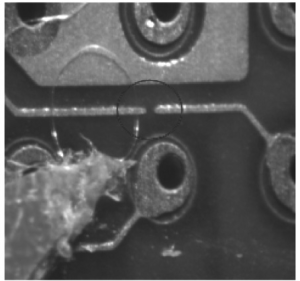
Figure 5 Line break caused by garbage in the exposure machine
2.1.3 Influence of graphic transfer development effect
The developer of water-soluble dry film is 1%~2% anhydrous sodium carbonate aqueous solution. The development mechanism is that the carboxyl active group in the unexposed part of the photosensitive film reacts with dilute alkali solution to form a colloidal polycarboxylate and is dissolved. Dirty developer and inappropriate development parameters may cause residual glue on the developed plate surface, the residual glue can not be plated or the thickness of copper plating is not enough, forming copper plating pits. Since 1 L of developer can dissolve 0.25 m2 of dry film, i.e. 0.3 m2 of printed board, the area of the developed product has an important impact on the development effect. The printed circuit board production line of our research institute initially changed the developer according to the product processing cycle, and later verified the influence of the area of the developer processed products on the probability of copper plating pits (see Table 1).
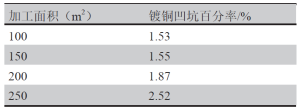
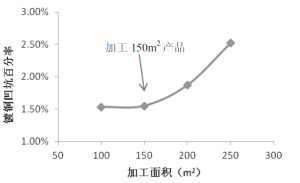
Table 1 Effect of processing area of developer on copper plating pits Figure 6 Trend of processing area and percentage of copper plating pits
It can be seen from Figure 6 that with the increase of processing area, the probability of copper plating pits increases. When the processing area is greater than 150 m2, the percentage of copper plating pits increases sharply. Therefore, we changed the way of developing solution slotting, and stipulated that the developing solution should be slotted every 150 m2 of product processed. During the maintenance of the developing tank, the general alkaline cleaning and acid cleaning cannot completely clean the dirt inside the pipeline, and the special cleaning agent should be used every month for cleaning.
2.2 Storage time from development to electroplating
The time period from development to electroplating is very important. Because the copper on the printed board surface is exposed to the air for a long time, it will react with O2, CO2, water, etc. in the air, resulting in deep oxidation of the copper surface, which is difficult to remove before graphic electroplating, and copper plating pits are caused during electroplating. The pattern was not transferred to electroplating in time after transfer, and the retention time was too long (up to 4 days), which caused the oxidation of the plate surface to be difficult to remove, and formed copper plating pits (as shown in Figure 7). Prolonged storage time will also cause the dry film to rise and lead to problems such as infiltration plating. It is generally recommended that the storage time from development to electroplating should not exceed 48 hours.
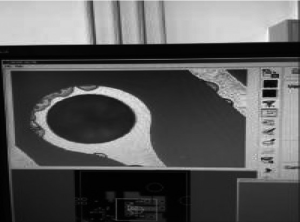
Figure 7 Copper plating pit
3 Improvement effect tracking
After the optimization of process parameters and strict control of production process for graphic transfer and graphic electroplating processes, the scrap rate of copper plating pits at the current stage was counted (see Table 4), in which the scrap rate of double-sided plates decreased from 1.88% to 0.42%, and the scrap rate of multi-layer plates decreased from 2.11% to 0.85%. The number of scrapped copper plating pits has been reduced by more than three times
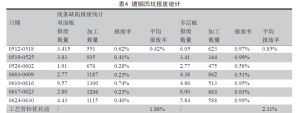
4 Summary
This paper analyzes the mechanism and causes of copper plating pits from the perspective of graphic transfer and graphic electroplating process, printed circuit board and puts forward improvement measures to significantly reduce the scrap rate of copper plating pits. Through this analysis, it can be seen that good solution maintenance, regular cleaning of each tank and strict control of all details have improved the quality of copper plating.

分享到: